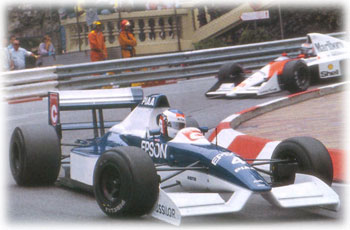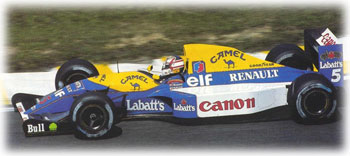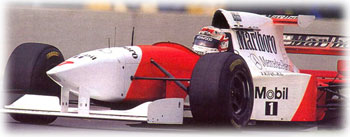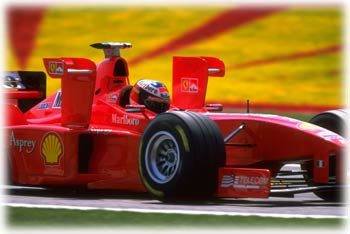The 1990 Formula One season saw the continuation of the duel between Ayrton Senna and Alain Prost. However, the two superstars were no longer driving as teammates, as the French 'professor' had switched to Ferrari. The contest was decided in Suzuka where Senna had been disqualified a year earlier. A few hundred metres after the start, Senna secured the title as he collided with Prost's Ferrari. Both cars slid out of the race, and with that Senna was placed out of reach at the head of the points table before the final in Adelaide had even taken place. The twist to the tale: the Brazilian had announced the crash 24 hours beforehand while reminiscing about the bitter defeat of the previous year.
 Two years after the banning of turbo engines, it became clear that the change in the rules had not had the desired effect of keeping a check on costs. Manufacturers were now expending between 15 and 30 per cent more money to build the regulation 3.5 litre induction units than they had previously spent on the six-cylinder turbos.
Two years after the banning of turbo engines, it became clear that the change in the rules had not had the desired effect of keeping a check on costs. Manufacturers were now expending between 15 and 30 per cent more money to build the regulation 3.5 litre induction units than they had previously spent on the six-cylinder turbos.
The investments bore fruit, though: with more than 700 hp, the induction engines broke the specific power barrier of 200 hp per 1000 cc of capacity for the first time. On the aerodynamics front, the Tyrrell team set new standards. Constructors Dr. Harvey Postlethwaite and Jean-Claude Migeot created the 'high nose', a component which quickly became an indispensable feature of modern Formula One.
Ayrton Senna also remained in front in 1991. But in the 42nd Formula One season, a driver took the wheel who had what it takes to compete with the giants Senna, Prost and Mansell: Michael Schumacher. The young man from Germany got his first opportunity when Jordan driver Bertrand Gachot was forced to take time out for legal reasons. After the very first practice session for the Belgian Grand Prix, many acknowledged the great talent of the newcomer, tipping him for future wins and even World Championship titles.
True to the forecast, Michael Schumacher drove like an upcoming champion in preparation test runs. Despite warning words and a request to approach the limits with great caution, he had soon rounded the club circuit at Silverstone faster than Jordan regular Andrea de Cesaris had ever managed. The Jordan team management gave him a rocket for 'disobedience', but he assured them successfully that he had only trundled round as ordered.
Schumacher was already out of the green Jordan cockpit by the next World Championship race in Monza. Flavio Briatore, then head of the Benetton stable, had secured the services of the super-talent with the aid of some crafty lawyers.
1992 saw the superior construction of the Williams-Renault FW14B achieve absolute dominance. The British team equipped the cars with active chassis, an idea originating in the eighties and since perfected. Controlled by computer, the chassis adapted itself to the immediate driving conditions. Traction control, which automatically prevented unwanted wheel-spin when accelerating, helped the car to victory. Nigel Mansel drove from victory to victory, and had already achieved an unbeatable lead in the intermediate rankings after the Hungarian Grand Prix in August.
It was on that weekend that new regulations came into force which affected the fuel of the Formula One cars. Aside from nitrogen and oxygen, both in limited quantities, the fuel was now only allowed to contain hydro-carbons. Alcohol, nitrogen compounds and other 'hp-friendly' additives were disallowed. Only a year later, the fuel regulations were brought into force which are still valid today. They dictated that the fuel had to comply with all the health and safety rules of the European Union. With that the officials had finally opened the way for gas station petrol in Formula One racing.
 At the beginning of the 1990s, oil companies were experimenting with more than 300 different mixtures each season, whereas now they are limited to only a few. The racing fuel, which in conjunction with the necessary engine tuning is responsible for a certain increase in power, is different not by virtue of its chemical components but only on account of their proportions. Since 1995, the fuel used must be identical in composition to a sample (chemical fingerprint) which is submitted in advance to the racing authorities for approval.
At the beginning of the 1990s, oil companies were experimenting with more than 300 different mixtures each season, whereas now they are limited to only a few. The racing fuel, which in conjunction with the necessary engine tuning is responsible for a certain increase in power, is different not by virtue of its chemical components but only on account of their proportions. Since 1995, the fuel used must be identical in composition to a sample (chemical fingerprint) which is submitted in advance to the racing authorities for approval.
Ayrton Senna, who last won the WC title in 1991, looked set for great success again in 1994, when he joined the Williams team. Williams-Renault had been providing the champions since 1992, and the year before, Alain Prost had left active racing with a fourth title win.
However, events transpired differently: at the outset of the racing year, Senna made a driving error at his home Grand Prix, spinning and leaving the race. In Aida, Japan, he was the innocent victim of a collision. The Grand Prix entourage then made a guest appearance in Imola, but the weekend was to turn out a tragedy.
On Friday, Rubens Barrichello crashed in spectacular fashion but escaped with minor injuries. The shock came on Saturday: Austrian Roland Ratzenberger suffered a fatal accident during the qualifying session. It was the first time in twelve years that a death had marred a Grand Prix weekend.
Ayrton Senna died the next day.
Probably as a result of a broken steering column - although the cause of the accident was never entirely clarified - he left the track in the Tamburello corner and smashed into a wall. The monocoque protected the driver's body, but parts of the front right hand suspension bounced back and inflicted fatal head injuries. Formula One had lost one of its best ever drivers.
Benetton ace Michael Schumacher was able to secure the title, although not without much controversy throughout the year. Next year, with the engines now limited to a capacity of three litres, he went all out again. This reduction was a result of the fatalities at Imola. Neither Ratzenberger nor Senna had been victims of excessive engine power, but the officials wanted to make a gesture nevertheless.
With a second title win in view, Schumacher went searching for a new challenge. In August 1995 he had decided to switch to Ferrari at the end of the season. Since Jody Scheckter in 1979, Ferrari had not been able to produce any champions. Schumacher was set to change that. With three victories in 1996 he started an upwards trend for the world-famous Scuderia. However, this was not enough to threaten the renewed Williams dominance. Damon Hill took the title just ahead of his teammate Jacques Villeneuve.
Despite the fact that Ferrari's internal plan did not foresee World Championship victory until 1998, Michael Schumacher was already reaching for the stars in 1997: placed at the top of the intermediate rankings, the Ferrari driver travelled to the final in Jerez, Spain. But at the deciding moment his nerves got the better of him, and Williams driver Jacques Villeneuve triumphed.
 The 1998 season produced a turn-around at the top of the Formula One hierarchy. The Williams team, who had set the tone since 1992, were toppled from their throne. Neither title-holder Jacques Villeneuve nor the holder of the runner-up position, Heinz-Harald Frentzen, could win a single race. One reason for the disappointing zero success rate: partner of many years, Renault, was no longer with them, and the "Mecachrome" engine installed as an alternative lacked power.
The 1998 season produced a turn-around at the top of the Formula One hierarchy. The Williams team, who had set the tone since 1992, were toppled from their throne. Neither title-holder Jacques Villeneuve nor the holder of the runner-up position, Heinz-Harald Frentzen, could win a single race. One reason for the disappointing zero success rate: partner of many years, Renault, was no longer with them, and the "Mecachrome" engine installed as an alternative lacked power.
What caused a sensation before the season began were the new technical rules: the car width was reduced from two metres to 180 centimetres. Parallel to that, larger cockpits were stipulated for safety reasons. Yet the most important new paragraph in F1 technical history related to the tyres.
In place of the conventional treadless slicks, what was known as rib tread tyres now came into use. Four longitudinal grooves on the rear rubber tyre and three on the front reduced the surface contact with the tarmac. With this action the FIA officials declared war on the dangerously high cornering speeds. From 1999 an additional front tyre groove was intended to further increase the severity of this paragraph. A fourth modification was submitted later, after four of the total of 16 World Championship races: it was no longer permissible to fit what are known as x-wings - two small additional wings on the side box bodies.
Only minor changes to the rules made it possible for the teams to concentrate on further development during the winter of 1999/2000. There was an innovation where fuel was concerned: from this season, Formula One is using an ultra clean fuel which complies with a new EU directive. The maximum sulphur content has been significantly reduced and the proportion of aromatic additives lowered from 42% to 35%.
 But 2000 was not to be remembered in the history of F1 for technical changes, but rather for the long awaited Ferrari World Championship. For the first time since 1979, Michael schumacher and the Scuderia Ferrari clinched both titles - Schumacher securing his third title with one race to go; Another F1 ghost was finally put to rest.
But 2000 was not to be remembered in the history of F1 for technical changes, but rather for the long awaited Ferrari World Championship. For the first time since 1979, Michael schumacher and the Scuderia Ferrari clinched both titles - Schumacher securing his third title with one race to go; Another F1 ghost was finally put to rest.
The third millenium and the sixth decade of Formula One technological advancement are looking set to take a step forward in technology, and a step backward in time: drivers' aids - high-tech electronics - which were banned from Formula One in 1994, are now making their way back to the sport. In the Computer and Internet age it was perhaps inevitable. And while many may mourn the regression in the driver's role versus the car's, Formula One was always about excellence. Excellence of men, in the cockpit and in the factory.
It will continue to be just that.